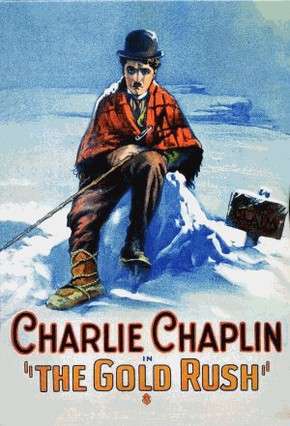The Gold Rush

Charlie Chaplin plays "The Lone Prospector", that is, the Tramp in Alaska during the Alaska Gold Rush. Charlie, blundering around the snowy mountains, winds up stuck in a cabin with considerably more competent prospector Big Jim McKay (Mack Swain). Big Jim and Charlie are reduced to eating Charlie's shoe, and Big Jim nearly eats Charlie before Charlie finally shoots a bear. After eating they part ways amicably. Big Jim stumbles across a very rich gold strike ("a mountain of gold!") as well as fugitive murderer Black Larsen (Tom Murray), who hits Jim in the head, causing him to have amnesia.
Charlie makes his way into the nearest gold rush boom town, gets a job cabin-sitting for another prospector, and falls in love with haughty dance-hall girl Georgia (Georgia Hale). Georgia loves another, ladies' man Jack Cameron, and teases Charlie. Eventually Big Jim, who remembers that he found a mountain of gold but can't remember where it is, runs into Charlie in the town and gets Charlie to lead him back to where the claim was. Will the Lone Prospector find riches and true love?
Considered by some to be Charlie Chaplin's masterpiece. Added to the National Film Registry with the Registry's fourth induction class, in 1992.
Watch it here, on this very wiki.
- Eating Shoes: Chaplin is the Trope Namer.
- Everything's Worse with Bears: Averted. Bears taste better than shoes.
- Somehow played straight and averted at the beginning, when nearly as soon as the Tramp appears, already only wearing his Tramp clothes in a blizzard and wandering lost in the mountains, he starts getting followed by a bear without noticing. ...but then they just go in different directions after awhile. In the meantime, it is hysterical.
- Exactly What It Says on the Tin
- The Gay Nineties
- Gold Digger: Georgia truly grows to love Charlie, but both understand that she is looking for a rich husband and Charlie ultimately willing and able to fulfill that desire.
- Debatable. As the ending makes clear, Georgia has come to care about Charlie without knowing that he struck it rich--she believes that he is a stowaway and tries to hide him from the ship's stewards (he has put his old tattered Tramp clothes back on when they meet again).
- Gold Fever
- Happy Ending: One of the very few pure, unadulterated ones in the Chaplin canon where Charlie not only becomes a millionaire, but gets the girl afterward. It's even lampshaded in the 1942 narration.
- I Ate What??: Charlie's shoe.
- Literal Cliff Hanger: the cabin.
- Meat-O-Vision: Jim sees Charlie as a chicken. Possibly the Trope Maker.
- Narrator: Chaplin in the 1942 version.
- New Year Has Come: Jim finds Charlie at the New Year's party.
- No Name Given: As usual with Charlie's character.
- Recut: Chaplin released a new version of this film in 1942 after the coming of sound. He added an original score and replaced all the title cards with his own narration. Some alternate shots were used, a key plot point was changed (Georgia's love letter to Jack becomes a love letter to Charlie) and the last scene was cut from the movie completely. The Chaplin estate appears to consider this the definitive version, as it was on Disc 1 of the recent DVD release and the 1925 original was an "extra" on Disc 2.
- An alternative interpretation is that the silent version was only mastered for video in SD, and it would have been too difficult or expensive to remaster it in HD for the Blu-Ray.
- Snowed In: The first cabin sequence.
- Trauma-Induced Amnesia: Jim.
- Wanted Poster: How we find out about Black Larsen.
- Wealthy Ever After: Charlie and Big Jim find the mountain of gold at great personal risk and the story ends with them leaving the Klondike rich.